CADILLAC SEVILLE 1995 4.G Owners Manual
Manufacturer: CADILLAC, Model Year: 1995, Model line: SEVILLE, Model: CADILLAC SEVILLE 1995 4.GPages: 410, PDF Size: 19.98 MB
Page 251 of 410
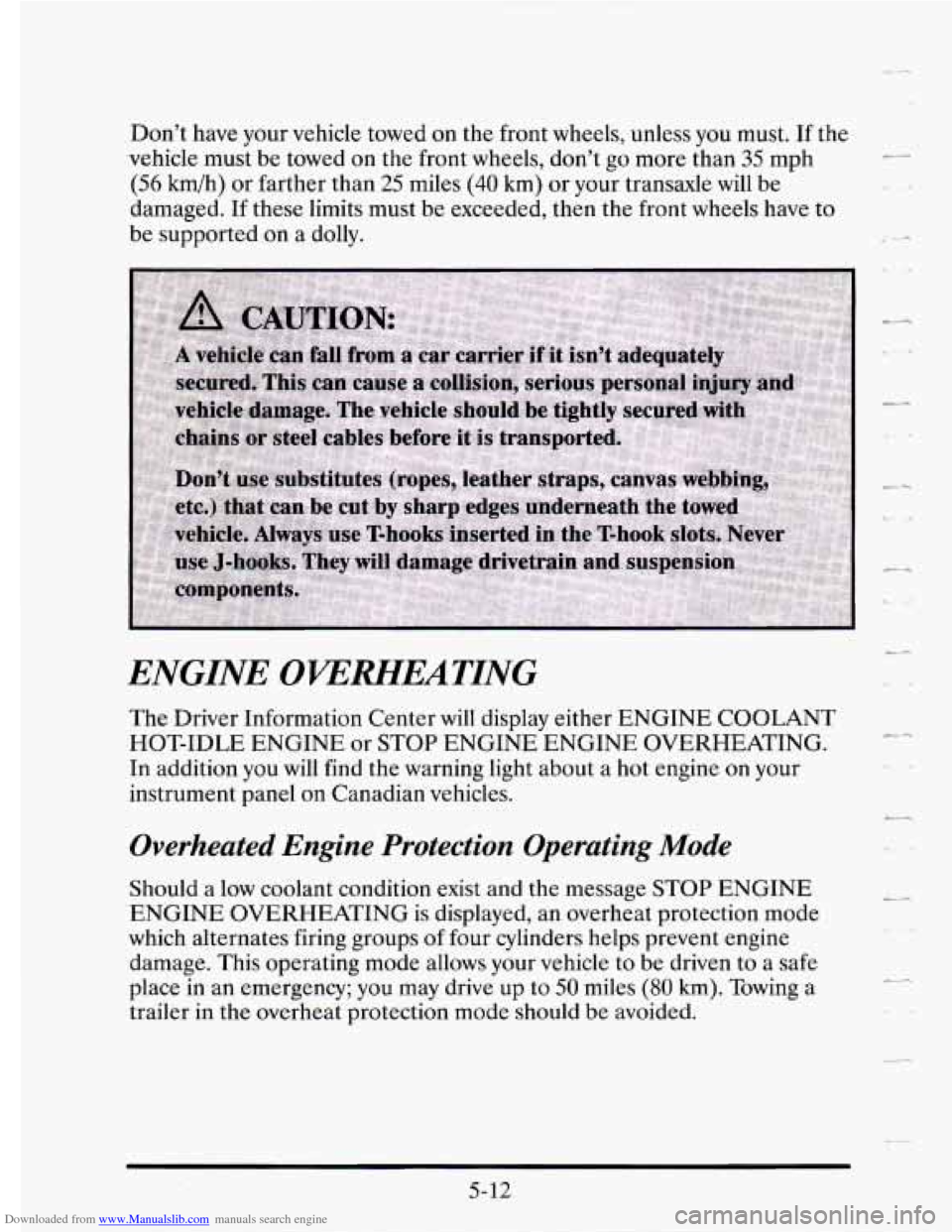
Downloaded from www.Manualslib.com manuals search engine Don’t have your vehicle towed on the front wheels, unless you must. If the
vehicle must be towed
on the front wheels, don’t go more than 35 mph
(56 kmih) or farther than 25 miles (40 km) or your transaxle will be
damaged. If these limits must be exceeded, then the front wheels have to
be supported on a dolly.
ENGINE OVERHEATING
The Driver Information Center will display either ENGINE COOLANT
HOT-IDLE ENGINE
or STOP ENGINE ENGINE OVERHEATING.
In addition you will find the warning light about a hot engine
on your
instrument panel
on Canadian vehicles.
6-4
Overheated Engine Protection Operating Mode
Should a low coolant condition exist and the message STOP ENGINE
ENGINE OVERHEATING is displayed, an overheat protection mode
which alternates firing groups
of four cylinders helps prevent engine
damage. This operating mode allows your vehicle
to be driven to a safe
place in an emergency; you may drive
up to 50 miles (80 km). Towing a
trailer
in the overheat protection mode should be avoided.
5-12
Page 252 of 410
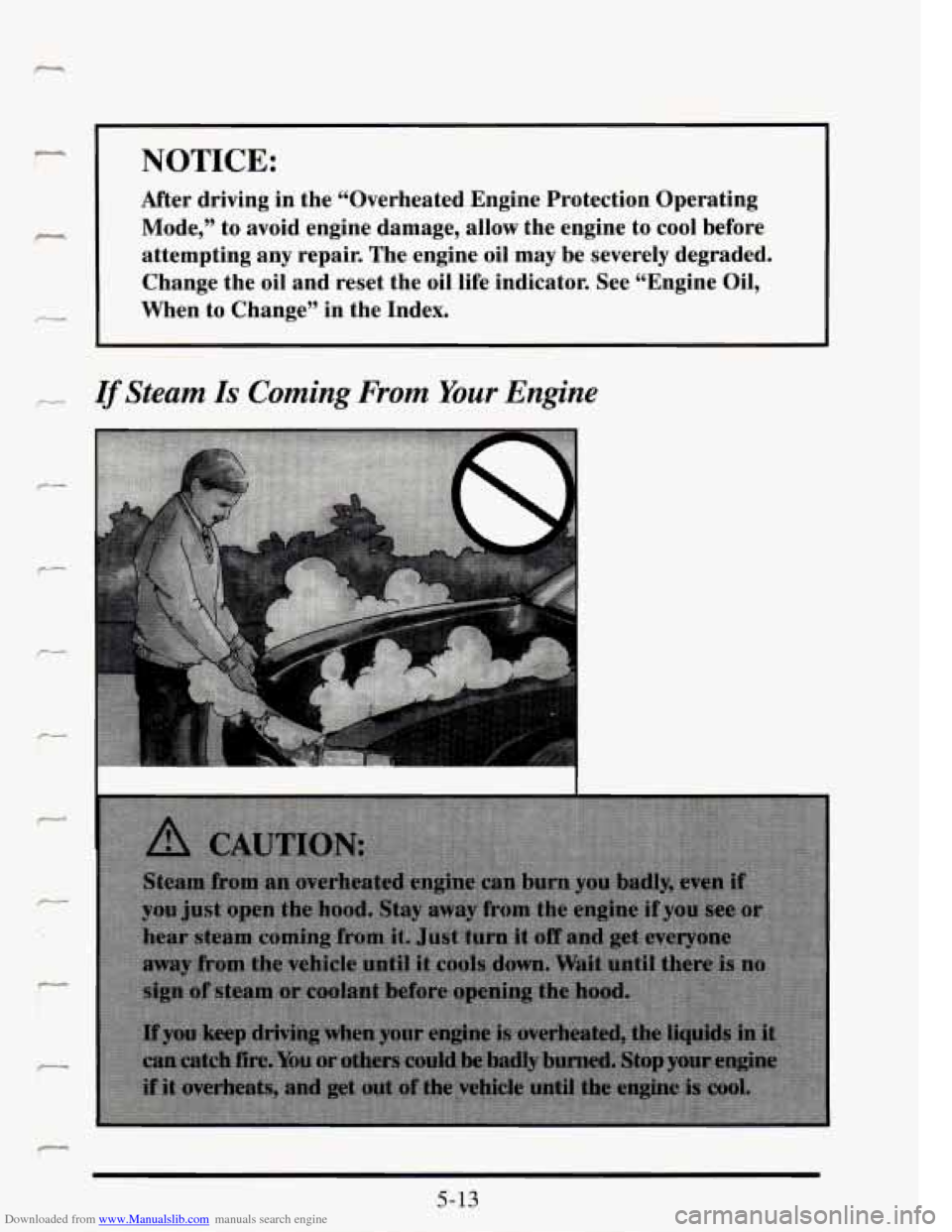
Downloaded from www.Manualslib.com manuals search engine NOTICE:
After driving in the “Overheated Engine Protection Operating
Mode,” to avoid engine damage, allow the engine to cool before
attempting any repair. The engine oil may be severely degraded.
Change the oil and reset the oil life indicator. See “Engine Oil,
When to Change” in the Index.
- If Steam Is Coming From Your Engine
f--
r
5-13
Page 253 of 410
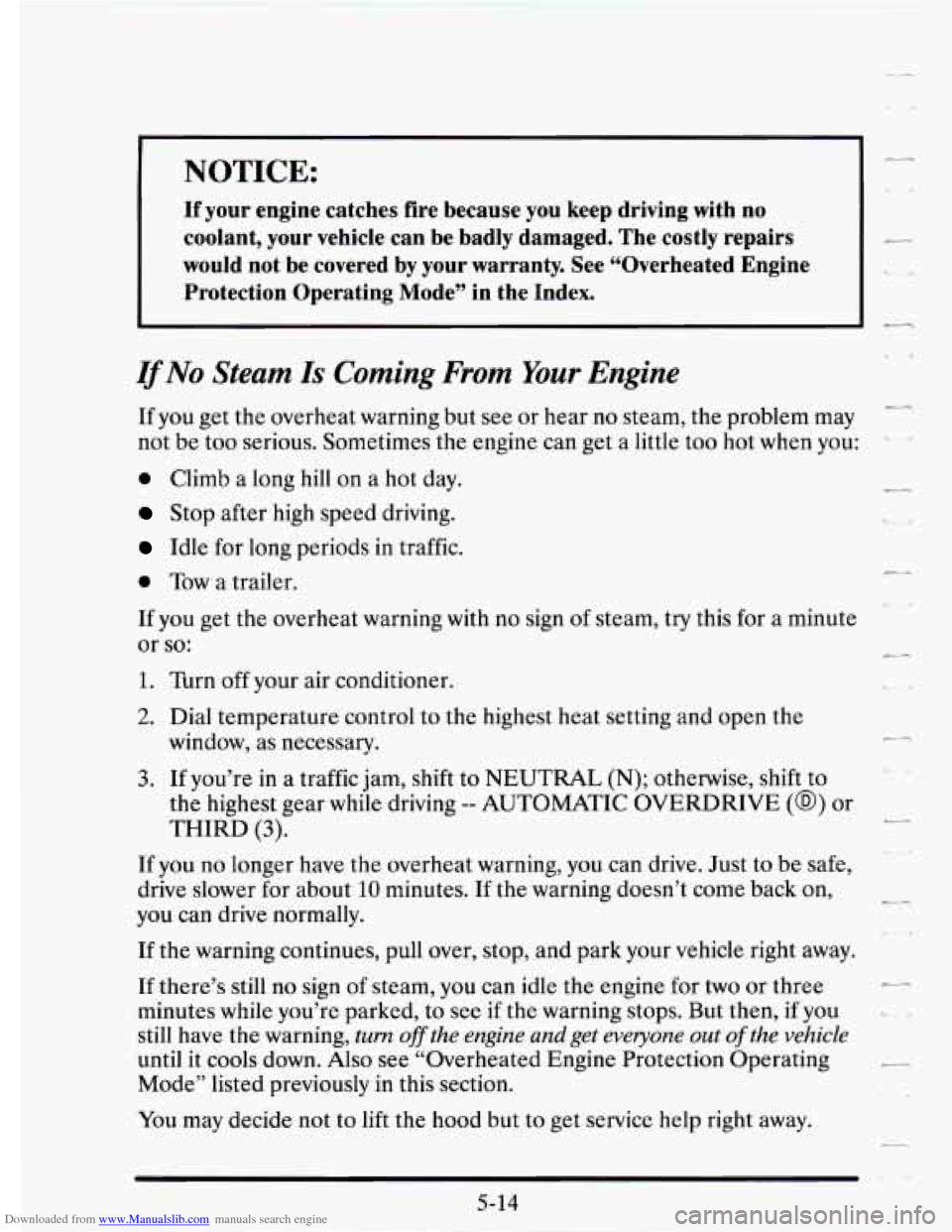
Downloaded from www.Manualslib.com manuals search engine NOTICE:
-
If your engine catches fire because you keep driving with no
coolant, your vehicle can be badly damaged. The costly repairs
I-
would not be covered by your warranty. See “Overheated Engine
Protection Operating Mode” in the Index.
I‘
lj?Nu Steam Is Coming From Your Engine
If you get the overheat warning but see or hear no steam, the problem may
not be too serious. Sometimes the engine can get
a little too hot when you:
-
0 Climb a long hill on a hot day.
Stop after high speed driving.
Idle for long periods in traffic.
0 Tow a trailer.
If you get the overheat warning with no sign
of steam, try this for a minute
or
so:
1. Turn off your air conditioner.
2. Dial temperature control to the highest heat setting and open the
window, as necessary.
3. If you’re in a traffic jam, shift to NEUTRAL (N); otherwise, shift to
the highest gear while driving
-- AUTOMATIC OVERDRIVE (@) or
THIRD
(3). -
If you no longer have the overheat warning, you can drive. Just to be safe,
drive slower for about
10 minutes. If the warning doesn’t come back on,
you can drive normally.
L
c4
If the warning continues, pull over, stop, and park your vehicle right away.
If there’s still no sign of steam, you can idle the engine for two or three
minutes while you’re parked, to see if the warning stops. But then, if you
still have the warning,
turn ofithe engine and get everyone out of the vehicle
until it cools down. Also see “Overheated Engine Protection Operating
Mode” listed previously
in this section.
You may decide not to lift the hood but to get service help right away.
5-14
Page 254 of 410
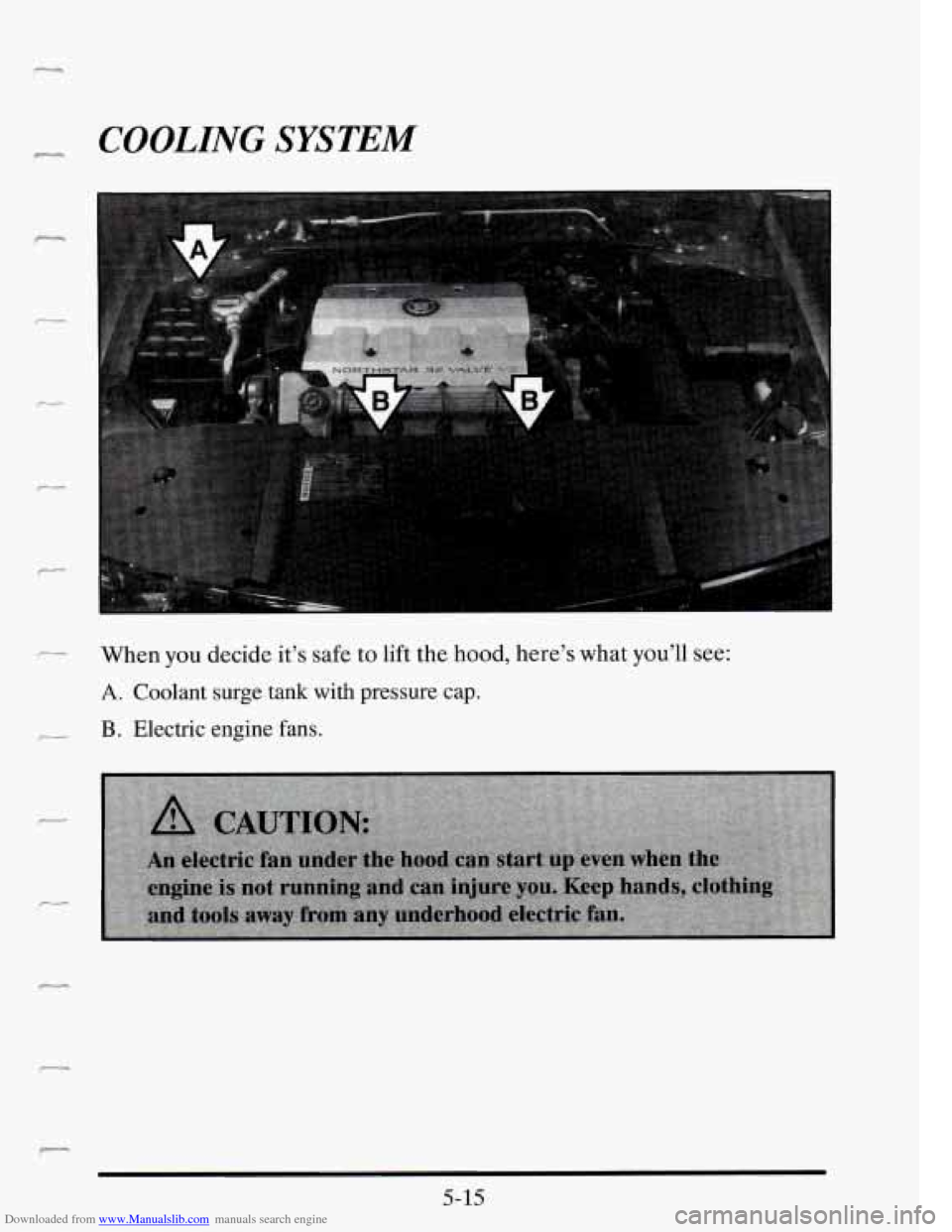
Downloaded from www.Manualslib.com manuals search engine ,-
- COOLING SYSTEM
- When you decide it’s safe to lift the hood, here’s what you’ll see:
- B. Electric engine fans.
A. Coolant surge tank with pressure cap.
5-15
Page 255 of 410
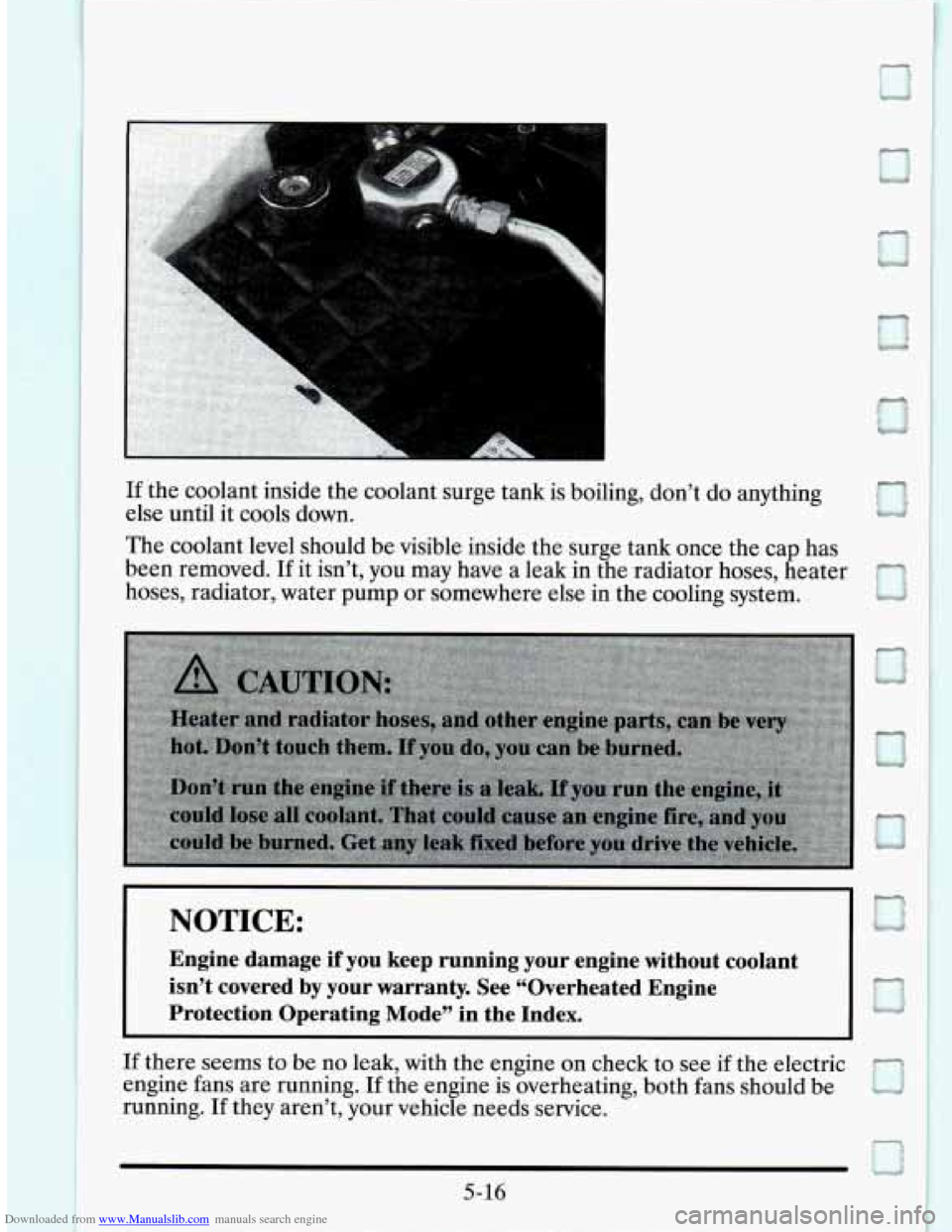
Downloaded from www.Manualslib.com manuals search engine 13
a
If the coolant inside the coolant surge tank is boiling, don’t do anything
else until it cools down.
The coolant level should be visible inside the surge tank once the cap has
been removed.
If it isn’t, you may have a leak in the radiator hoses, heater
hoses, radiator, water pump or somewhere else in the cooling system.
a
I NOTICE: I R
Engine damage if you keep running your engine without coolant
isn’t covered
by your warranty. See “Overheated Engine
Protection Operating Mode” in
the Index.
If there seems to be no leak, with the engine on check to see if the electric
engine fans are running.
If the engine is overheating, both fans should be
running. If they aren’t, your vehicle needs service.
a
5- 16
Page 256 of 410
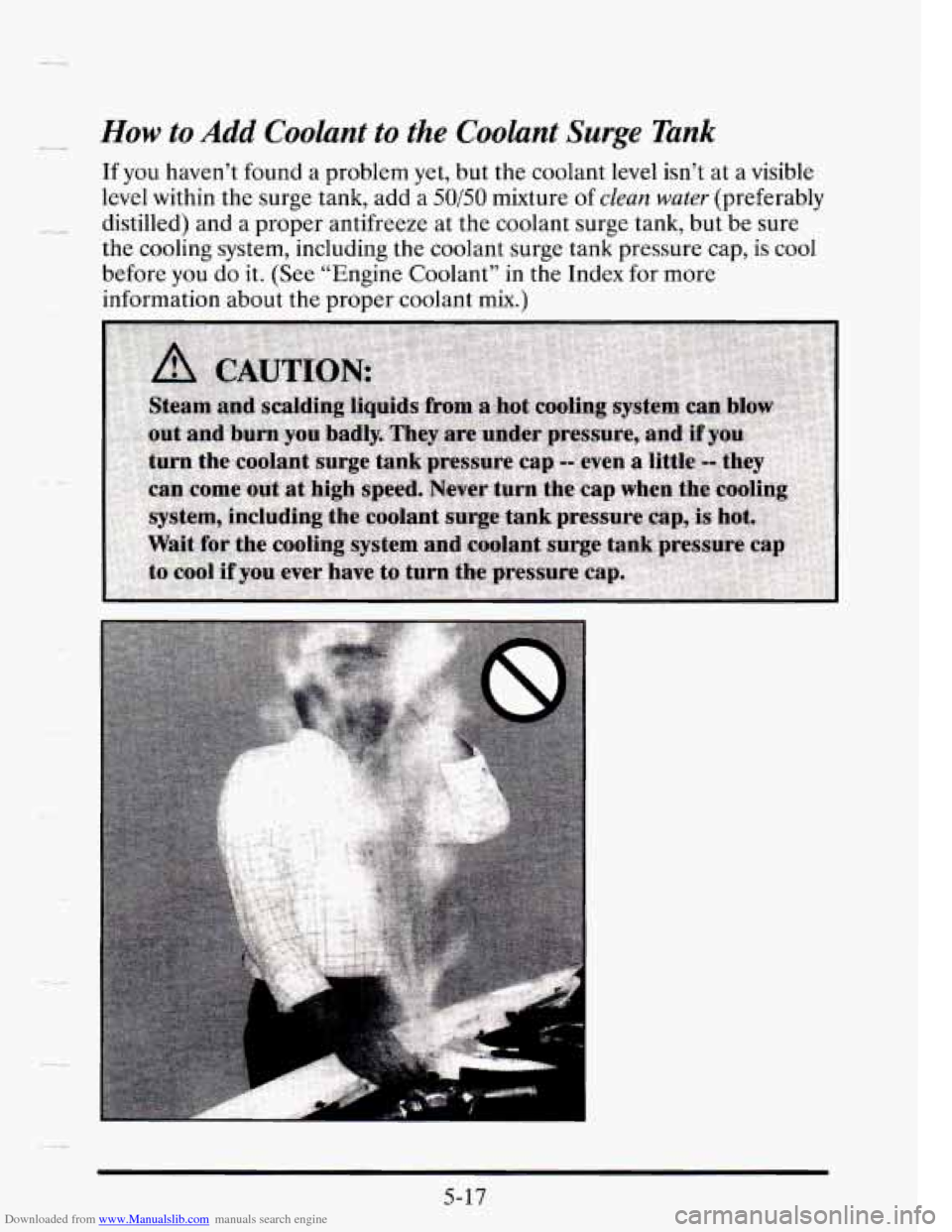
Downloaded from www.Manualslib.com manuals search engine -- How to Add Coolant to the Coolant Surge Tank
If you haven’t found a problem yet, but the coolant level isn’t at a visible
level within the surge tank, add
a 50/50 mixture of clean water (preferably
the cooling system, including the coolant surge tank pressure cap,
is cool
before
you do it. (See “Engine Coolant” in the Index for more
information about the proper coolant
mix.)
- distilled) and a proper antifreeze at the coolant surge tank, but be sure
5-17
Page 257 of 410
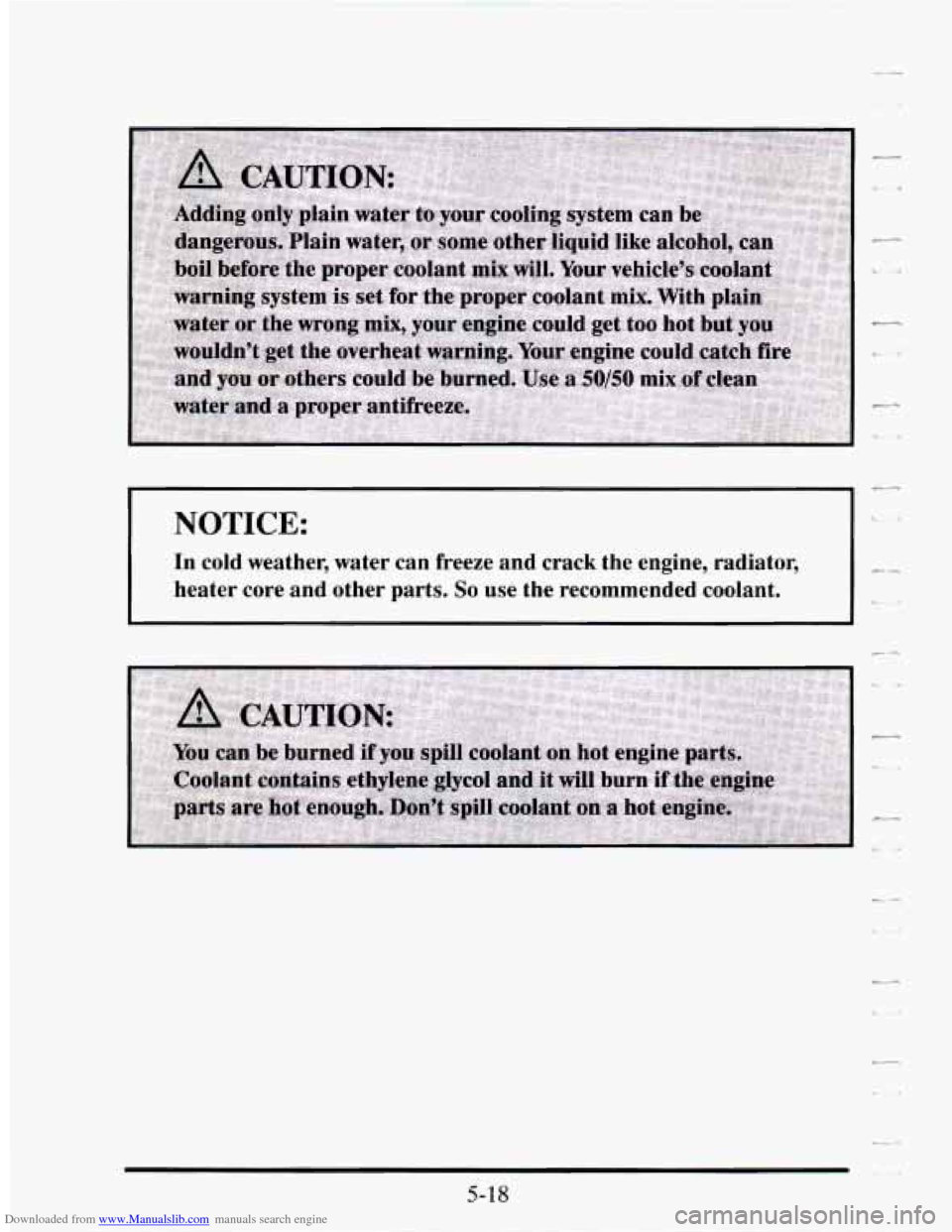
Downloaded from www.Manualslib.com manuals search engine I I
NOTICE:
In cold weather, water can freeze and crack the engine, radiator, --
heater core and other parts. So use the recommended coolant.
L
Page 258 of 410
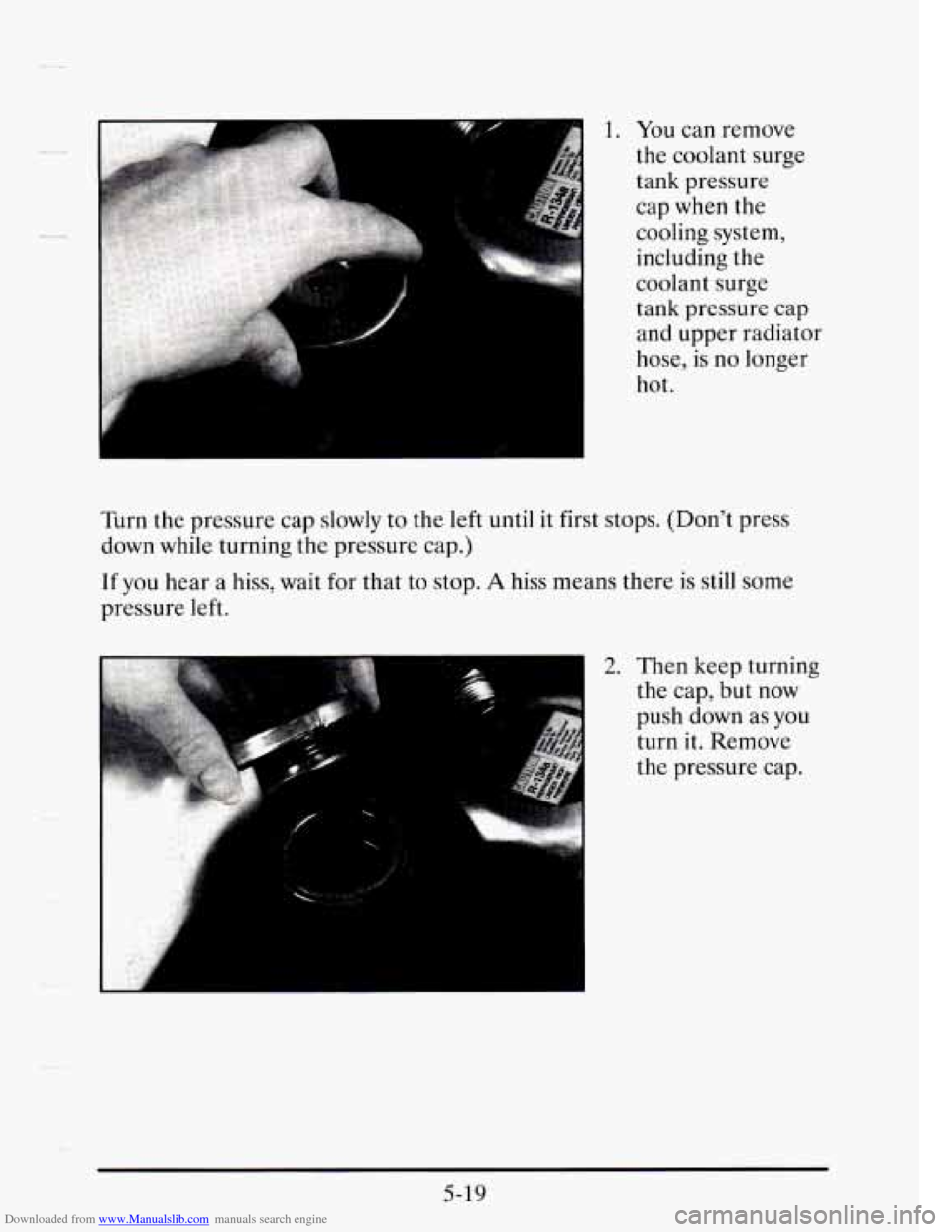
Downloaded from www.Manualslib.com manuals search engine 1. You can remove
the coolant surge
tank pressure
cap when the
cooling system,
including the
coolant surge
tank pressure cap
and upper radiator
hose, is no longer
hot.
Turn the pressure cap slowly to the left until it first stops. (Don't press
down while turning the pressure cap.)
If you hear a hiss, wait for that to stop. A hiss means there is still some
pressure left.
2. Then keep turning
the cap, but now
push down as you
turn it. Remove
the pressure cap.
5-1 9
Page 259 of 410
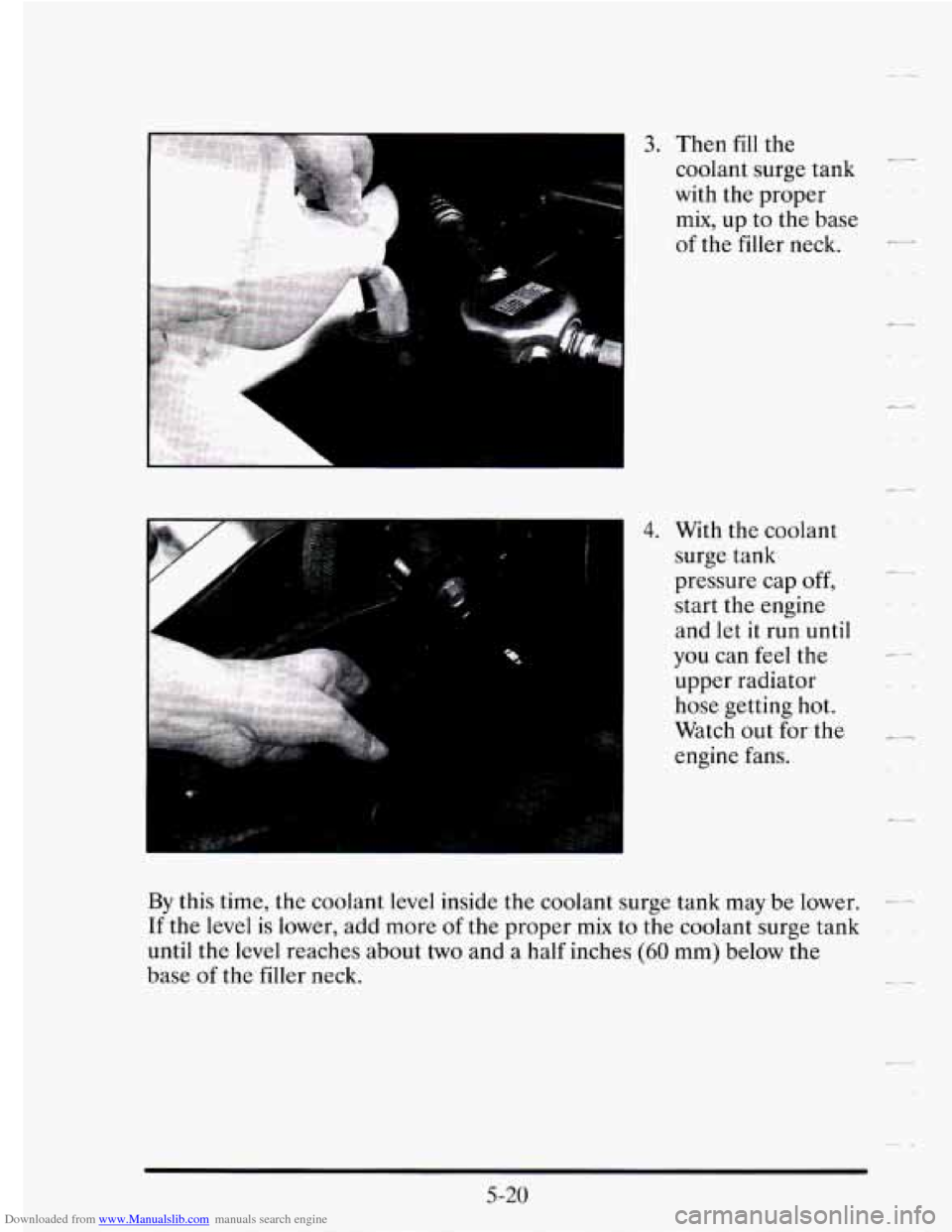
Downloaded from www.Manualslib.com manuals search engine I 3. Then fill the p_ coolant surge tank
with
the proper
mix, up to the base
of the filler neck.
Zd
- 4. With the coolant
surge tank
pressure cap off,
start
the engine
and
let it run until
you can feel the
upper radiator
hose getting
hot.
Watch out for the
engine fans.
By this time, the coolant level inside the coolant surge tank may be lower. --
If the level is lower, add more of the proper mix to the coolant surge tank
until the level reaches about
two and a half inches (60 mm) below the
base
of the filler neck.
5-20
Page 260 of 410
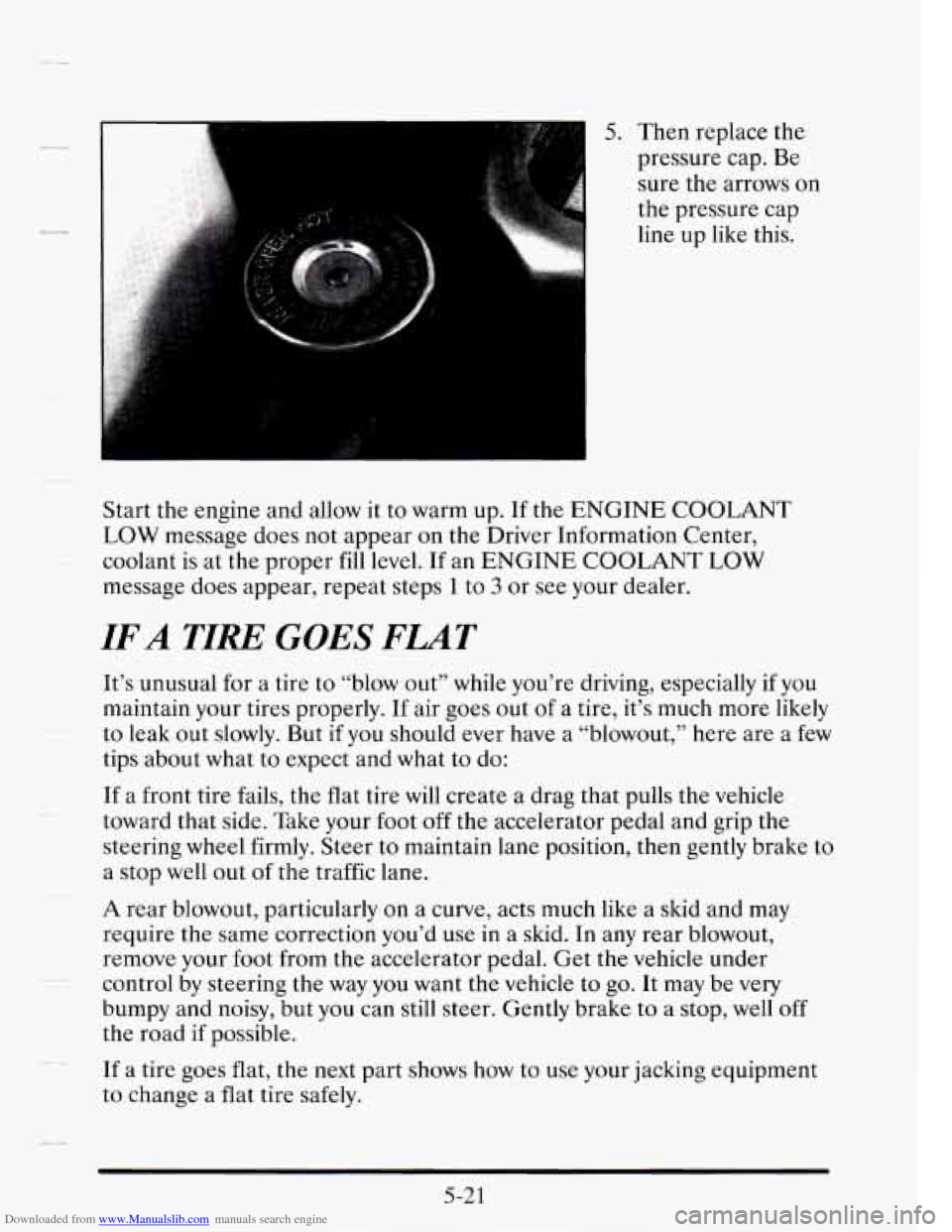
Downloaded from www.Manualslib.com manuals search engine 5. Then replace the
pressure
cap. Be
sure the arrows on
the pressure cap
line up
like this.
Start the engine and allow
it to warm up. If the ENGINE COOLANT
LOW message does not appear on the Driver Information Center,
coolant
is at the proper fill level. If an ENGINE COOLANT LOW
message does appear, repeat steps 1 to 3 or see your dealer.
IFA TIRE GOES FLAT
It’s unusual for a tire to “blow out” while you’re driving, especially if you
maintain your tires properly.
If air goes out of a tire, it’s much more likely
to leak out slowly. But if you should ever have a “blowout,” here are a few
tips about
what to expect and what to do:
If a front tire fails, the flat tire
will create a drag that pulls the vehicle
toward that side. Take your foot off the accelerator pedal and grip the
steering wheel firmly. Steer to maintain lane position, then gently brake to
a stop well out of the traffic lane.
A rear blowout, particularly on a curve, acts much like a skid and may
require the same correction you’d use in a skid. In any rear blowout,
remove your foot from the accelerator pedal. Get the vehicle under
control by steering the way you want the vehicle
to go. It may be very
bumpy and noisy, but you can still steer. Gently brake to a stop, well off
the road
if possible.
If
a tire goes flat, the next part shows how to use your jacking equipment
to change a flat tire safely.
5-2 1